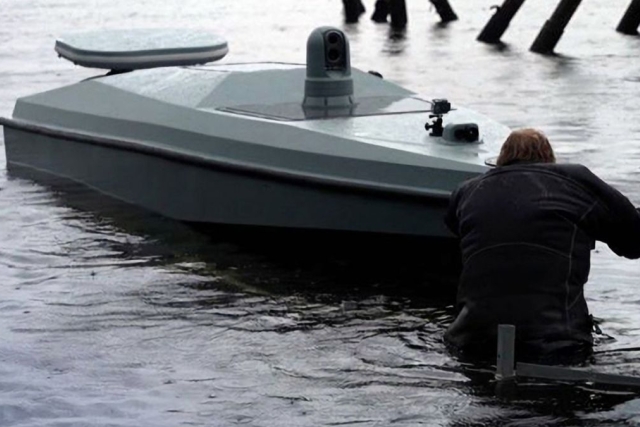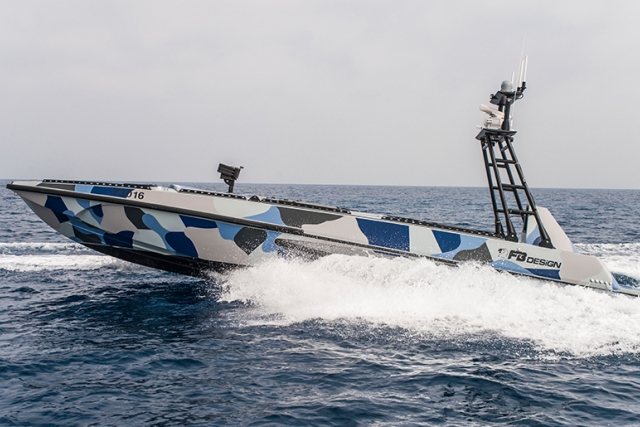Development Trends in Unmanned Surface Vessels
Defense Mirror provides insights into specific drone boats and their features.

MAGURA V5
Unmanned surface vessels (USVs) have caught the attention of the world following their spectacular success in sinking Russian warships in Ukraine.
The rapid growth of USVs in recent times mirror the rise of unmanned air vehicles (UAVs) a decade ago. Today, several countries have working USVs and many more are on the way.
Aside of their best-known role as explosive-packed kamikaze drones in Ukraine, USVs perform various functions such as reconnaissance, surveillance, search-and-rescue and mini electronic warfare platforms. Some of them have been equipped with missiles and remote weapon stations to perform some of the tasks of manned assault ships.
USVs offer an improved alternative to traditional manned boats. They can forward deploy in high-risk missions where concern for the security and safety of the crew is substantial. USVs enable long-range transits in rough sea conditions and can operate on the surface without putting the crew in harm’s way. USVs have proven to deliver advancements in autonomy for greater situational awareness and improve maritime missions by delivering intelligence besides enabling manned-unmanned teaming.
Ukraine's use of the MAGURA V5 Unmanned Surface Vessel (USV) against high-profile Russian warships in the Black Sea emphasizes the strategic value of USVs for naval superiority. These vessels offer reduced risk, cost-efficiency, and rapid deployment while minimizing personnel risk and logistical demands.
Another Ukrainian USV, the Sea Baby, is said to be involved in an incident to strike at the base of the Crimea bridge linking Russian mainland with the disputed Crimean Peninsula.
Collaboration with unmanned aerial vehicles (UAV) or manned-unmanned teaming with fighter aircraft in a sensor-to-shooter configuration is the next big development for USVs.

Some developments are equipping the USVs with missiles and remote weapon systems to take on sea or shore-based targets.
Defense Mirror provides insights into some prominent USV projects.
|
Country |
Unmanned Surface Vessel (USV) (Manufacturer) |
Features |
|
Ukraine |
MAGURA V5 (FTE SPETSTECHNOEXPORT) |
Length: 5.5 m; Height: 0.5 m; Payload: 320 kg; Range: 800 km
|
|
Sea Baby (Security Services of Ukraine) |
Length: 6 m; Width: 2 m; Height above water level: 0.6 m; Speed 90 km/h; Range: 1000 km; Payload: 850 kg; Engine: 400 HP |
|
|
Turkey |
ULAQ (Ares Shipyard and Meteksan Defence Systems) |
Length: 11 m; Speed: 35 knots; Range: 400 km. Armament: Four laser-guided Cirit missiles and two laser-guided long-range anti-tank missiles (L-UMTAS) |
|
|
SALVO (Dearsan Shipyard) |
Length: 14.79 m; Width: 3.83 m; Draft: 0.75 m; Speed: 60 knots Armament: surface-to-surface and surface-to-air guided missiles, 12.7 mm stabilized machine gun. |
|
SANCAR |
Dimensions: 12.7 m x 3.3 m (lxw); Speed: 40 knots; Displacement: 9 tons; Propulsion: 2 x Diesel Engines coupled to 2 x Waterjets; Cruising range: 400 nm at 10 knots; Cruise time of 40 hours; Seaworthiness: Sea State 4; telescopic mast up to 4 meters; return-to-home feature in case of emergencies. KALYON Mission System, Mobile Ground Control Station, Payload-Compatible Task Assignment, C2 Integrated Uninterrupted Communication, 12.7 mm Remote Controlled Weapon System, Tactical Missile Weapon System, Side Scan Sonar, and Ship Data Distribution System. |
|
|
ALBATROS-S |
Speed: ≥ 40 knots; Endurance: ≥ 10 hours; Engine: Diesel; Payload capacity: 250 kg; Communication systems include mesh RF, satellite, and 4.5 G/LTE. Autonomy features encompass autonomous mission planning, task distribution, sensor fusion, and obstacle detection for dynamic route planning. |
|
|
MIR |
Length: 15 m; Beam: 3.85 m; Displacement: 21-ton; Top speed: 35 knots; Range: 400 nautical mile; Payload: Four-ton, Endurance: 72-hour |
|
|
Israel |
KATANA |
Length: 11.9m; Width of 2.81 m; Platform weight: 6,500 kg; Top speed: 60 knots, Cruising speed: 30 knots; Engine: Two maritime diesel engines (2x560 Hp); Endurance: 350 nm; Payload capacity: 2,200 kg. |
|
Australia |
Sentinal (Austal) |
Large patrol boat modified for autonomy functions, will potentially contribute to the Large Optionally Crewed Surface Vessels (LOSV) project of the Australian Navy |
|
Qatar |
Suhail (Performace Marine) |
Suhail is a 39-foot USV that integrates L3Harris’ ASView control system technology. ASView enables unmanned or remote operations from ashore or sea-based control stations. |
|
United States |
Common Uncrewed Surface Vehicle (Textron Systems) |
The CUSV has demonstrated sensor-to-shooter collaboration with an unmanned aerial vehicle besides engaging and shooting at multiple targets in another demonstration |
Ukraine
MAGURA V5
On February 1, 2024 Ukraine utilized MAGURA V5 to destroy Russia's Ivanovets missile corvette in an operation carried out near Lake Donuzlav in occupied Crimea. Ukraine's Main Intelligence Directorate (GUR) disclosed that Ukrainian-made MAGURA V5 USVs delivered six direct hits to the hull of the Russian vessel.
A fortnight later, Russia’s large landing ship "Caesar Kunikov" sunk after a Global Hawk drone-guided MAGURA USVs struck it from the side. Videos of the large ship keeling over and vanishing below the water’s surface are all over the internet. The MAGURA unmanned boats were reportedly guided by a NATO -Global Gawk drone.
SEA BABY
Andriy Yusov, spokesperson for Ukraine's Military Intelligence Directorate, has brought attention to the deployment of Sea Baby USVs in various operations, including the destruction of a portion of the Crimean Kerch Bridge in July 2023.
In October 2022, Sea Baby drones from the SBU special unit attacked ships in Sevastopol Bay, damaging Russian frigates causing damage to the Admiral Makarov and Admiral Essen frigates, along with the minesweeper Ivan Golubets and the patrol ship Ladny.
Subsequent Sea Baby attacks in 2023 damaged several warships, including the Samum missile battleship, Pavel Derzhavin, the SIG tanker, the Olenegorsky Gornyak amphibious assault ship, the Nikolay Mur tugboat, Buyan missile battleship, and Vladimir Kozitsky reconnaissance and hydrographic ship.
In Ukraine’s arsenal, the MAGURA V5 and Sea Baby USVs have achieved what bombers laden with anti-ship missiles and torpedoes and backed up by a first-rate air defense, would have accomplished.
USVs can be launched from various platforms including warships, patrol boats and sea-shores. Smaller USVs can be brought close to launching point by helicopters. Depending upon the mission, their hulls can be coated with stealthy paint reducing their exposure to radar.
Turkey
ULAQ USV
The ULAQ USV, developed jointly by Ares Shipyard and Meteksan Defence Systems, represents Turkey's first domestically produced armed USV.
The ULAQ is designed to perform various tasks, including intelligence gathering, surveillance, reconnaissance, surface warfare, escort missions, and protection of infrastructure.
The ULAQ has undergone sea trials and achieved initial operational capability, as demonstrated during the Denizkurdu 2021 exercise.

SALVO USV
Another Turkish firm, Dearsan Shipyard's SALVO combat USV is designed for autonomous reconnaissance, intelligence operations, surface warfare, anti-submarine warfare, and base protection.
The SALVO conducted live firing trials in the Sea of Marmara, featuring Roketsan's CIRIT missile on May 25, 2022. Another trial involved an Aselsan-made 12.7 mm remote weapon station (RWS), resulting in target hits.
SANCAR USV
The SANCAR USV is a collaboration between Turkish companies Havelsan and Yonca Onuk, designed for network-centric operations. Launched in June 2022, it completed initial sea trials by September of the same year.
SANCAR AUSV features a communication infrastructure utilizing RF/GSM/SAT systems. Controlled from a mobile Ground Control Station with an ADVENT C4ISR mission system which is compliant with NATO Inter-operability standards. This adaptability extends to deployment on other naval platforms using ADVENT.
The platform is designed for various tasks, including port/base protection, search and rescue, intelligence, reconnaissance, surveillance, patrol, surface warfare, and mine countermeasures.
Key features encompass COLREG Compliant Autonomous Navigation, ADVENT ROTA & ADVENT KALYON Mission System, C2 Integrated Communication, 12.7 mm Remote Controlled Weapon System, Missile Weapon System, Side Scan Sonar, and Ship Data Distribution System.
ALBATROS-S
The Albatros-S is designed for various applications, such as reconnaissance, surveillance intelligence, engaging targets, coast guard patrol, offensive operations, and port defense. The portable control console supports autonomous mission planning, live view/record applications, ensuring adaptability for maritime operations in various conditions.
MIR USV
The MIR USV, unveiled in June 2022 by Sefine Shipyard, is an Anti-Submarine Warfare (ASW) vessel featuring variable depth sonar (VDS) for defensive ASW operations in littoral waters, with the flexibility for additional roles in surface drone swarms.
On April 18, 2023, MIR successfully fired a light torpedo, marking the first Turkish USV torpedo launch.
Israel
KATANA
The KATANA supports dual-mode operations, enabling the vessel to function either as a USV or a manned platform with a quick switch-over. This flexibility allows for risk-free remote execution of specific tasks. The system can be installed on different vessels, sharing the same baseline architecture for consistent autonomous navigation and mission planning.
Applications for the KATANA span firefighting, search and rescue, intelligence gathering, fleet defense, security and patrol duties as well as mine-counter-measures and anti-submarine-warfare.
Dutch USV concept
The Netherlands defense ministry and Dutch Naval Design announced on April 13 2024 a partnership to develop USVs for maritime operations, expected to be ready for deployment in about four years.
These USVs, measuring 12 meters in length, will work alongside Anti-Submarine Warfare frigates scheduled for delivery around 2030. Currently, frigates utilize helicopters for anti-submarine missions, but the USVs will provide additional capabilities in this domain.
Australia
Sentinal USV
The collaborative Patrol Boat Autonomy Trial (PBAT) project, led by Austal Australia, has completed Sea Acceptance Trials for the autonomous vessel Sentinel off the Western Australian coastline. The vessel used in the trials, Sentinel (formerly HMAS Maitland), underwent extensive modifications to enable remote and autonomous operations, including upgrades to navigation, communications, bilge, CCTV, and electrical systems. Greenroom Robotics added sensors and computer units to support the Autonomous Control System, GAMA.
The Sentinal, will potentially contribute to projects like the Large Optionally Crewed Surface Vessels (LOSV) recently announced by the Australian Government.
Qatar
Suhail USV
L3Harris and Qatari shipbuilder Performance Marine showcased the first locally-built autonomous Unmanned Surface Vehicle (USV), Suhail, at the 2024 Doha International Maritime Defense Exhibition and Conference (DIMDEX).
Designed and locally manufactured by Performance Marine, Suhail is a 39-foot USV that integrates L3Harris’ ASView control system technology. ASView, an open architecture software with embedded artificial intelligence and machine learning, enables unmanned or remote operations from ashore or sea-based control stations to execute pre-planned missions or autonomously adapt to dynamic conditions.
United States
Common Uncrewed Surface Vehicle- UAV, USV Perform Sensor-to-Shooter Co-ordination in U.S. Navy Exercise.
The U.S. Navy utilized the Aerosonde UAV and the Common Uncrewed Surface Vehicle (CUSV) to execute a full detect-to-engage sensor-to-shooter mission exercise. Notably, the CUSV executed the live-fire engagement using a small USV integrated with a missile system.
Equipped with the LIG Nex1 Poniard missile system, the CUSV demonstrated its capability to utilize UAS data for tactical decision-making and target engagement.
Textron Systems’ CUSV engages multiple targets.
In another exercise, the Textron Systems’ CUSV, executed multiple Fast Inshore Attack Craft missions against a moving target. The demonstration marked the first instance of a small USV engaging multiple surface targets in a single salvo.
Textron's CUSV demonstrated the ability to be retrofitted with various payloads including options for expeditionary warfare, surface warfare, and intelligence, surveillance, and reconnaissance (ISR) payloads.
European Union
EUROGUARD USV project
Inspired by Ukraine’s use of Unmanned Attack Boats, the European Union Kicks off Similar Project in Estonia.
The European Defence Fund (EDF) has launched a project led by an Estonian firm, Baltic Workboats to develop small drone vessels.
The EUROGUARD project has officially commenced in Estonia with an investment of almost €100 million. The project involves a collaboration between 23 enterprises and the cooperation of 10 EU Member States.
The primary objective of this initiative is to develop a modular and semi-autonomous surface vessel platform equipped with a remote-control system, aiming to strengthen sea defense capabilities across Europe.









